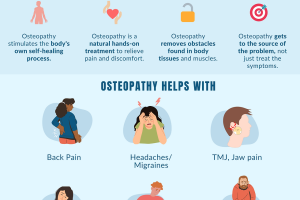Unlocking the Secrets of Healthy Living with Osteopathy

Introduction to Osteopathy
What is Osteopathy?
Osteopathy is a holistic form of healthcare focused on the interconnectedness of the body’s systems. It emphasizes treating the whole person rather than just addressing specific symptoms. Practitioners, known as osteopathic physicians, leverage their comprehensive training to assess and treat a wide array of health concerns. Many patients find that osteopathy complements traditional medical approaches, providing them with a well-rounded path to wellness. Just like Sarah, who struggled with chronic headaches for years. After consulting with an osteopathic practitioner, she discovered that her headaches were related to tension and misalignment in her neck and spine. With targeted treatments and lifestyle changes, she not only alleviated her pain but also improved her overall health.
- Unlocking the Secrets of Healthy Living with Osteopathy
- Introduction to Osteopathy
- What is Osteopathy?
- Principles of Osteopathic Medicine
- Benefits of Osteopathy for Overall Health
- Improving Posture and Body Alignment
- Managing Pain and Inflammation
- Understanding the Role of Osteopathic Practitioners
- Osteopathic Manipulative Treatment (OMT)
- Holistic Approach to Healthcare
- Incorporating Osteopathy into Your Wellness Routine
- Osteopathic Techniques and Modalities
- Osteopathy as Complementary Medicine
- Osteopathy for Specific Health Conditions
- Osteopathy for Back Pain
- Osteopathy for Joint Problems
- Research and Studies on the Efficacy of Osteopathy
- Evidence-Based Practice in Osteopathic Medicine
- Osteopathic Treatments for Various Health Issues
- Osteopathy and Preventive Care
- Promoting Long-Term Health and Wellbeing
- Preventing Injuries and Health Issues
- Finding a Qualified Osteopathic Practitioner
- Importance of Choosing an Accredited Professional
- Questions to Ask Before Starting Osteopathic Treatment
Principles of Osteopathic Medicine
The practice of osteopathy is rooted in several core principles, which include:
- The Body as a Whole: Osteopaths view the body as an integrated entity.
- Self-Healing Ability: They believe that the body has an innate ability to heal itself.
- Biomechanics Focus: Emphasis is placed on the structural and functional relationships within the body.
These guiding philosophies support a personalized approach, allowing patients to experience holistic and sustainable health improvements.
Benefits of Osteopathy for Overall Health
Improving Posture and Body Alignment
One of the standout benefits of osteopathy is its focus on improving posture and body alignment. Many people, whether from desk jobs or daily habits, develop poor posture, which can lead to a host of problems. Julie, for example, spent hours hunched over a computer, resulting in back and neck pain. After a series of osteopathic treatments, she learned techniques to enhance her posture and realign her spine, which drastically reduced her discomfort. Key aspects of improving posture through osteopathy include:
- Hands-on techniques: Osteopaths employ gentle manipulative treatments to realign misaligned joints.
- Muscle retraining: Patients are often given exercises to strengthen core muscles, which supports better posture in the long run.
Managing Pain and Inflammation
Osteopathy also excels in managing pain and inflammation, making it a valuable option for many individuals. From sports injuries to chronic conditions, osteopathic care can provide relief. John, an avid runner, turned to osteopathy after suffering from persistent knee pain. Through targeted manipulative treatment and advice on recovery strategies, he found relief and was soon back to his regular running routine. Some benefits include:
- Reduced reliance on medication: Osteopathic methods help alleviate pain naturally.
- Improved mobility: Treatments can enhance flexibility and range of motion.
This approach not only helps to manage pain but promotes overall well-being.
Understanding the Role of Osteopathic Practitioners
Osteopathic Manipulative Treatment (OMT)
Central to the osteopathic approach is Osteopathic Manipulative Treatment (OMT), a hands-on technique that practitioners utilize to diagnose and treat various health issues. OMT focuses on the body’s musculoskeletal system, aiming to promote healing and enhance overall wellness. For instance, when Mike experienced persistent lower back pain, his osteopath applied OMT techniques to relieve tension and improve alignment. After a few sessions, Mike experienced significant relief and was amazed by the effectiveness of this approach. OMT techniques can include:
- Stretching: Enhancing flexibility in tight muscles.
- Resistance techniques: Strengthening weak areas to improve function.
- Joint mobilization: Restoring proper movement and alignment.
Holistic Approach to Healthcare
What sets osteopathic practitioners apart is their commitment to a holistic approach to healthcare. They view each patient as a whole person, considering physical, emotional, and environmental factors. For example, when Sam sought help for anxiety and tension headaches, his osteopath took time to discuss his lifestyle, stressors, and overall health goals. This comprehensive understanding allowed for a tailored treatment plan that combined OMT, relaxation techniques, and nutritional guidance. Key features of this holistic approach include:
- Patient-centered care: Focusing on individual needs and preferences.
- Preventive measures: Encouraging healthy lifestyle choices to maintain well-being.
This dedication ensures that patients receive not just treatment but also education for lasting health benefits.
Incorporating Osteopathy into Your Wellness Routine
Osteopathic Techniques and Modalities
Incorporating osteopathy into your wellness routine can be a game-changer for both physical and mental health. Osteopathic practitioners utilize a variety of techniques to promote healing and improve well-being. For example, Anna, who was struggling with chronic shoulder stiffness, found significant relief through a combination of techniques like myofascial release and cranial osteopathy. Some common osteopathic techniques include:
- Soft Tissue Manipulation: Easing tension in muscles and fascia.
- Muscle Energy Techniques: Using the patient’s own muscle contractions to improve movement.
- Structural Integration: Aligning the body’s structure to support optimal functioning.
These modalities not only alleviate discomfort but also enhance overall body function.
Osteopathy as Complementary Medicine
Osteopathy shines as a complementary medicine, working alongside conventional treatments to provide comprehensive care. For instance, after undergoing surgery, James integrated osteopathy into his recovery plan. His practitioner collaborated with his surgeon, ensuring all aspects of health were addressed. Benefits of viewing osteopathy as complementary medicine include:
- Holistic Support: Addressing not just symptoms, but the root causes of health issues.
- Enhanced Recovery: Supporting traditional treatment methods with natural healing approaches.
By incorporating osteopathy into your routine, you create a balanced approach to maintaining optimal well-being.
Osteopathy for Specific Health Conditions
Osteopathy for Back Pain
Back pain is one of the most common complaints that leads individuals to seek osteopathic treatment. Through a combination of hands-on techniques and personalized care plans, osteopathic practitioners address both acute and chronic back pain effectively. For example, when Laura began experiencing lower back pain after lifting heavy boxes, her osteopath conducted a thorough assessment. With OMT, they identified misalignments in her spine and worked to alleviate her pain through targeted manipulation and rehabilitation exercises. Common osteopathic approaches for back pain include:
- Spinal Manipulation: Aligning the vertebrae to relieve pressure on nerves.
- Stretching and Strengthening Exercises: Building core stability to support the back.
This comprehensive approach helps not only to relieve pain but also to prevent future issues.
Osteopathy for Joint Problems
Joint problems, such as arthritis or sports injuries, can be effectively managed through osteopathic care as well. Michael, a weekend warrior who injured his knee during a soccer match, found relief after undergoing treatment from an osteopathic practitioner. Through gentle manipulation, his osteopath improved his joint mobility and provided advice on safe exercises. Key osteopathic strategies for joint problems include:
- Soft Tissue Techniques: Reducing inflammation and enhancing joint function.
- Education on Joint Protection: Helping patients understand how to protect their joints in daily activities.
With osteopathy, patients often experience improved mobility and reduced pain, paving the way for an active lifestyle.
Research and Studies on the Efficacy of Osteopathy
Evidence-Based Practice in Osteopathic Medicine
As the field of osteopathy grows, so does the importance of evidence-based practices. It’s crucial that treatments are supported by research and clinical studies that demonstrate their effectiveness. For instance, a recent study indicated that osteopathic manipulative treatment significantly reduces chronic pain in patients, leading to better quality of life. Tom, a participant in such a study, found that after several sessions, he not only experienced pain relief but also improved his overall mobility. Key aspects of evidence-based practice in osteopathy include:
- Clinical Trials: Rigorously studying the effects of osteopathic treatments on various health conditions.
- Peer-Reviewed Research: Validating osteopathic techniques through independent research.
Osteopathic Treatments for Various Health Issues
Osteopathic treatments are not one-size-fits-all; they can effectively address a range of health issues, from headaches to musculoskeletal disorders. Research has shown positive outcomes, such as decreased pain levels and improved function. For example, Sarah, who struggled with asthma, participated in a study showcasing how osteopathy helped improve her breathing patterns by addressing tension in the diaphragm. Commonly researched health issues treated with osteopathy include:
- Migraines and Tension Headaches: Techniques that relieve muscular tension in the head and neck.
- Chronic Pain Syndromes: Integrating osteopathy in comprehensive treatment plans enhances recovery processes.
With continued research, osteopathy proves to be a valuable asset in modern healthcare.
Osteopathy and Preventive Care
Promoting Long-Term Health and Wellbeing
Incorporating osteopathy into a preventive care strategy is a proactive way to promote long-term health and well-being. Osteopaths take a holistic view, emphasizing the importance of maintaining balance within the body to prevent future health issues. For instance, Lisa, a busy professional, started attending monthly osteopathic sessions not just for relief from her occasional tension headaches, but also to ensure she was maintaining good overall health. Important aspects of long-term health promotion in osteopathy include:
- Regular Check-ups: Identifying and addressing potential issues before they become problematic.
- Tailored Wellness Plans: Creating personalized lifestyle and exercise guidelines to enhance physical health.
Preventing Injuries and Health Issues
Osteopathy is invaluable in preventing injuries, especially for active individuals. Athletes like David regularly seek osteopathic treatments to ensure their bodies are in optimal condition to minimize injury risk. Techniques employed by osteopaths help maintain flexibility and strength, as well as joint function. Some key preventive strategies include:
- Movement Education: Teaching patients proper body mechanics and postural awareness.
- Rehabilitation Exercises: Implementing tailored exercises to strengthen vulnerable areas.
By focusing on preventive care, osteopathy empowers individuals to lead healthier lives and reduce the likelihood of injuries and chronic conditions.
Finding a Qualified Osteopathic Practitioner
Importance of Choosing an Accredited Professional
Finding a qualified osteopathic practitioner is crucial for ensuring you receive safe and effective care. Choosing someone accredited by recognized professional organizations can significantly impact your treatment outcomes. For example, when Samantha began her search for an osteopath after experiencing prolonged back pain, she specifically looked for a practitioner accredited by the American Osteopathic Association. This gave her confidence that she was in skilled hands. Key reasons for choosing an accredited professional include:
- Training and Education: Accredited practitioners undergo rigorous training in osteopathic principles and techniques.
- Regulatory Standards: Accreditation ensures that practitioners adhere to specific ethical and professional standards.
Questions to Ask Before Starting Osteopathic Treatment
Before committing to treatment, it’s essential to ask questions that can help you gauge the practitioner’s approach and expertise. Here are some questions you might consider:
- What is your experience with my specific condition?
- What treatment methods do you use, and how do they work?
- Can you share any patient success stories or testimonials?
By asking these questions, patients like Samantha can feel more informed and empowered about their healthcare decisions, ensuring they receive the best osteopathic care tailored to their needs.





